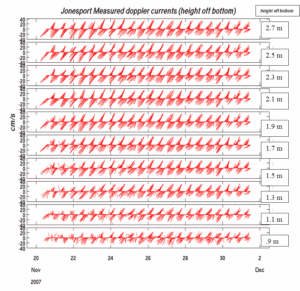Determining the Effect of Eastern Maine Bottom Currents on Groundline
 In May 2007, GOMLF received Northeast Consortium development funds to measure bottom currents off of Jonesport-Beals, in eastern Maine. Collaborating with oceanographers and lobstermen, GOMLF sought to examine the effect of bottom currents on lobster gear in nearshore eastern Maine waters, to establish whether bottom currents there are strong enough to significantly reduce the profile of floating rope used as groundline between traps, thus reducing the risk of whale entanglements in lobster gear.
In May 2007, GOMLF received Northeast Consortium development funds to measure bottom currents off of Jonesport-Beals, in eastern Maine. Collaborating with oceanographers and lobstermen, GOMLF sought to examine the effect of bottom currents on lobster gear in nearshore eastern Maine waters, to establish whether bottom currents there are strong enough to significantly reduce the profile of floating rope used as groundline between traps, thus reducing the risk of whale entanglements in lobster gear.
GOMLF was hopeful that the data collected during this pilot project would be informative for the regulatory process leading up to the Final Whale Rule; however, the federal rule regulating the use of floating groundline in the lobster industry was finalized during this timeframe (issued in the Federal Register in October 2007, implemented in April 2009) and the project was ill-timed to factor into the process.
Nonetheless, current data from the bottom of the ocean has been unavailable until now and the methodologies employed in this project may be resurrected for future projects involving the impacts of current/tide on fixed gear.
